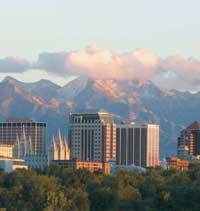A new light rail system has encouraged nightlife in Salt Lake‘s downtown market, and a shift from basic to more upscale tenants is beginning to occur. The largest catalyst for this shift, however, is expected to be a $1.5 billion real estate investment project by the Church of Jesus Christ of Latter-Day Saints and its development arm (known as Property Reserve), which is working with Taubman Centers on what is expected to be the largest investment effort in the Salt Lake region since the 2002 Winter Olympics. The project will redevelop 1 million square feet of space to include retail, housing, and office space.
In another project, Hamilton Partners of Itaska, Ill., plans to develop an approximate 50,000-square-foot tower downtown, with the potential to include retail and housing.
All of this activity is compounded by several major new infrastructure projects. The greatest of these are a $1.2 billion retrofit upgrade of the regional freeway system and a new light rail system, TRAX, which came online in December 1999. TRAX carries 43,000 people per day and more than 1.1 million riders per month.
Due in part to the success of TRAX, a commuter rail system broke ground in August 2005 with completion scheduled in part by 2008. The commuter rail will provide transportation from Davis County to Salt Lake City, and the announcement of a line servicing Utah County is anticipated within a year. After a protracted battle, the Legacy Highway also earned approval for construction. When completed, it will run from Davis County into Salt Lake City, taking pressure off an over-congested transportation route.
Future Directions
Salt Lake City’s new and improved ground transportation system gives renters the option of living in more diverse areas, including residential submarkets, without forgoing their ability to easily travel downtown for work and play. For renters and multifamily developers alike, this has opened new and more affordable site options on the outer perimeters of the metro area.
Many local Utah developers are ready to take advantage of–or in many cases already own–these sites, but are holding back due to the uncertain cost and supply of construction materials. They want to build and believe they will be successful, but they must wait until they are sure they can build with a bottom line that delivers an acceptable profit margin. Once these factors become more specifically defined and materials become more readily available, new apartments will certainly hit across the Salt Lake City market.
In terms of new construction, most developers are building to meet renter demand for amenities. Salt Lake City properties currently enjoying the greatest success are the amenity-heavy, newer suburban locations that offer direct access to a freeway interchange or light rail station.
For the first time since the 1980s, developers also are talking about building condominiums in the downtown market, with a potential of a handful of new mid-rise buildings between 10 stories and 15 stories. But the buzz is almost exclusively among local companies. Large national developers play only a minor role in the Salt Lake City market. While several have built significant projects here over the past decade, there are few if any projects under consideration right now by out-of-area entities.
Similarly, large national investors also tend to focus less on markets like Salt Lake City, but regional institutional investors remain very interested. The Irvine, Calif.-based Bascom Group, for example, recently bought a 262-unit, Class B project in the mid-valley south of downtown for $17.9 million. Horizon Realty Advisors has also been an active buyer along the Wasatch Front.
On the whole, multifamily insiders are upbeat about Salt Lake City. They believe that between concessions burning off, occupancies increasing, and the overtly positive direction of the Salt Lake City economy and quality of life, there is good news ahead.
